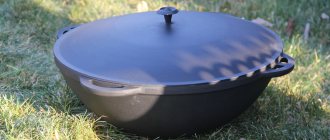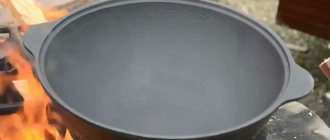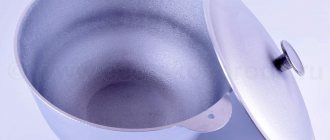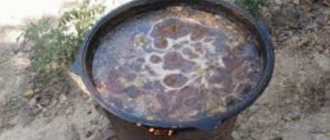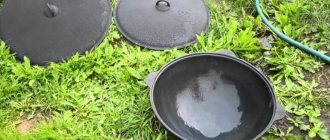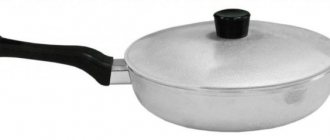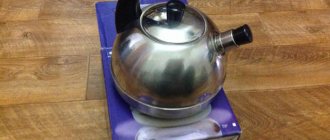A cauldron is the type of utensil with which you can prepare amazing pilaf, dumlyama, shurpa, etc.
Many people do not know that having bought a new cauldron, it cannot be immediately used for cooking. It is very important to calcinate before first use. This article will tell you why you need to carry out such actions and how you can do it.
What you need to know first
Unpleasant smoke, smell and taste in the cauldron is formed if the preparation of the cauldron for the first use was not carried out or something was done wrong. All foreign odors when working with a cauldron appear due to the fact that this type of kitchen equipment is generously coated with machine oil during manufacture. Or rather, it is not the cauldron itself that is lubricated, but the mold in which it is cast. This is done so that the future cauldron does not stick to the mold. Therefore, there is no way to do without primary processing after purchase. It is absolutely necessary to ensure that all remaining oil is removed. After which the cauldron must be heated, otherwise, at the end of cooking, its surface will be covered with rust, and the food will burn.
Myths
For some reason, it is generally accepted that cast iron cauldrons are of higher quality than aluminum ones. But this is nothing more than an exaggeration and not an entirely reliable fact.
They say that aluminum can be harmful to the human body. But purchasing from trusted companies will reduce the risk of harmful particles coming from products made from low-quality materials. Moreover, manufacturers test all materials for quality and comply with safety requirements. And when cooking a cauldron, a special protective film is formed that will protect the food from any impurities.
There is also an opinion that food in a cauldron will be cooked to a lower quality. This opinion is primarily due to the fact that such cookware has a thin layer of metal and it heats up faster, but the temperature is also lost faster. This is just a misconception. You can cook food in an aluminum cauldron very easily, you just need to adapt and choose the right temperature conditions.
Cooking pilaf in an aluminum cauldron.
One more thing. There is an opinion that aluminum cookware is short-lived. This is also a misconception. If it is properly and efficiently prepared, it will last for decades if used correctly.
Where can I prepare a cauldron for first use?
Both home and outdoor conditions are suitable for the process. But it is worth considering the presence of a considerable amount of smoke.
Heating a cauldron on a fire
Calcination at the stake is the best option. Dry firing is performed over a fire; after the grease burns out, a lighter grayish tint of the coating appears. You need to remove the cauldron from the snow or grass after it has acquired a uniform color. It must be washed and calcined again before use with periodic treatment with vegetable oil.
Customer Reviews
Leonid Minin
Kukmar's cauldron is a weighty dish. I am sure that it will not break or bend during transportation. It is important to properly remove the factory coating and immediately read on the Internet how to clean it from the inside and outside. The dishes are worth it!
Svetlana. Ekaterinburg
I bought a 5 liter cauldron especially for my husband. He is my classic hunter. That’s why I gave her a 5-liter aluminum cauldron. We don’t use it at home, but it’s a pleasure to use it outdoors, if you know how to cook and love it. They say that aluminum is not a material for food utensils, but, as I think, a cauldron is made of an alloy. Therefore, when heated, there will be no poison in the food, and even if this is possible, then such a product will not be allowed for sale.
Options for firing a new cast iron cauldron
So, we found out that the cauldron cannot be used immediately after purchase - it will need to be prepared for further use. Now it remains to figure out how to heat a new cast iron cauldron. The method used for this purpose depends on the environmental conditions:
- On the street above an open flame - an option for owners of a private house or cottage.
- On the kitchen stove - an option for owners of city apartments.
Firing a new cauldron indoors is not the most convenient way, since burning technical lubricant is accompanied by the release of acrid and thick smoke with the formation of soot. Firstly, it is harmful to health. And secondly, this is fraught with general cleaning. And thirdly, a specific smell can penetrate even into neighboring apartments.
Features of preparing an aluminum cauldron before using it for the first time
Cast duralumin is inferior in physical properties to traditional cast iron. Utensils become unusable faster and do not retain heat well. But aluminum has an undeniable advantage - light weight. It is difficult for a petite housewife to hold a cast iron cauldron with food; it is better to give her an aluminum one.
The second plus is that duralumin can be placed in the dishwasher.
The process of preparing aluminum casting for cooking is not much different from firing cast iron. Main differences.
- Aluminum cannot be overheated; the bottom will become rounded and the walls will become oval.
- It is better to use damp wood for a fire; they have a lower combustion temperature.
- Aluminum cookware requires 1/3 less time to prepare.
- It is not recommended to do dry calcination; you need to use salt or oil.
- Temperature shock (sharp temperature contrast) is undesirable for duralumin.
Once the firing is complete, free aluminum will not get into the food and will not enter into a chemical reaction with any product during cooking.
Restoring the non-stick layer after cleaning the cauldron
Treatment will allow you to return the usual properties of the dishes. After thorough cleaning, it will lose its characteristics and food will stick and burn. The usual color is lost.
Tips for restoring the non-stick layer
Washing with warm water, wiping dry, coating with salt and baking will help restore properties. If this has already been done, all that remains is to apply sunflower oil to the inside.
Other rules of care
After the first use of such aluminum cookware, it must be thoroughly cleaned of food residues. Under no circumstances should you soak this cauldron in water with detergents or leave it there for a long period.
It is better to immediately rinse the cauldron with clean water after use and gently wipe it dry with a sponge. This is the safest way to remove stuck food items. Then this dish is almost completely filled with water. The water is boiling. After which it merges. The dishes need to be gently wiped dry again, and then covered with a very thin layer of oil. After these procedures, the cauldron can be stored.
If for some reason your cauldron has been left unwashed for several hours, then food residues will stick to it very strongly. They were either dried out or burnt. There is only one way out - soaking the cauldron. Just do not use chemicals in this procedure. Regular warm water will do.
After thoroughly cleaning the cauldron, household salt (table salt) is placed in it and calcined. This operation takes one hour. The salt should darken and give off a nasty smell. When this happens, it pours into another container. The cauldron cools down completely. Oil is placed in it and calcined. That is, the same operation takes place as when preparing dishes for debut use.
Types of calcination
Firing a cast iron cauldron before the first cooking is simply necessary; there are several types of calcination; you can choose the most suitable one and prepare your kitchen utensils.
Calcination with table salt
Salt is poured onto the bottom of the vessel and placed on a hot stove or fire. The seasoning will absorb all the excess liquid and remaining oil, after which the cauldron will become completely suitable for preparing food. Together with salt, the utensils will smoke and smell less; immediately after they darken, turn off the stove and allow the cast iron to cool.
The seasoning will absorb all the excess liquid and remaining oil.
Oil treatment
After the standard calcination procedure, it is important to go through it again, but using oil. To do this, pour oil into the pan; if it is still hot, then use a potholder or a thick towel. Turn the cauldron so that all the walls are covered with oil, then place the container back on the open fire for ten minutes and wait until bluish smoke appears. To better lubricate the walls, take an ordinary long wooden spatula, which is wrapped in paper, and use it to distribute the oil along the walls of the kitchen utensil. This way it will penetrate into all the pores of the heated vessel and form a thin protective coating on the surface. Thanks to it, food will not burn to the bottom of the cauldron. After this procedure, all remaining contents are drained and the bottom of the container is wiped with a paper napkin.
Processing a cauldron in the oven
For this method, the oven is thoroughly heated to 180-200 degrees, the cauldron is washed with warm water without soap. Then place the dishes on a baking sheet and wait until dark smoke comes out of the cabinet doors. Allow the kitchen utensils to cool and wash with warm water, then dry with a towel.
Roasting over an open fire
Another method of effectively firing cast iron is firing over a fire. They hang the cauldron over the fire and wait until all the rusty spots disappear and the acrid gray smoke stops pouring out of the equipment. Kitchen utensils will begin to change color and become suitable for cooking.
Rules for firing a cauldron before first cooking
Food casting is fired so that the factory lubricant burns out. It turns into smoke and soot, which is removed with hot water and soap. The procedure for firing a cast-iron cauldron before the first cooking is lengthy and unpleasant: a fair amount of smoke is generated, and it does not smell like roses. Aluminum is processed faster; when working with it, several nuances must be taken into account. There are features of firing a cauldron.
The food turns out much tastier and more aromatic, since such dishes are cleaned of technical grease and undergo a procedure for renewing the protective coating with oil.
Note! Some manufacturers produce cauldrons with a black non-stick coating. This is a thin layer of durable enamel. It is not oily to the touch; when wiping new dishes, no stains remain on the napkin. If you pour water, rainbow stains will not appear on it.
Cast iron
Cast iron products are very heavy. Casting is done with thick walls, thanks to which the products simmer rather than boil or fry. Cast iron must be handled with care. If accidentally dropped, the metal may crack; the alloy is classified as brittle. Below is detailed instructions on how to fire a new cast iron cauldron over a fire and at home, what you will need for this.
Without proper processing, food cooked in a cauldron will simply be inedible and smell bad, and cooking in general will become impossible.
Note! Cast iron is not afraid of temperature contrasts. Previously, cast iron pots were fired in winter, thrown out of the fire into the snow, then wiped dry and put back on the fire. The procedure was repeated several times.
Aluminum
Aluminum alloy, or rather duralumin for casting, is valued for its low specific gravity. But the metal has one peculiarity: when unevenly heated, internal stresses form in it; the cauldron can become deformed if fired over high heat.
Correct calcination
Calcination and cleaning with salt is not recommended for use at home in the kitchen or indoors in general. Hot oil and salt can lead to burns, damage to furniture, fire, and acrid smoke will permeate your entire apartment.
It would be correct to transfer these procedures to the open air.
Let's clean it first
Cast iron has a porous surface and you will not be able to wash such dishes clean. Rust in hard-to-reach pores adds complexity. It will not allow a film to form in this place. We need to find a way to clean it properly.
Traditionally, cast iron cauldrons are cleaned with salt.
So, you already have a washed cauldron, there is a fireplace for the cauldron, firewood, 1-2 kg of table salt per 10 liters of cauldron volume and a convenient iron slotted spoon.
The process is slow and will take 2 hours of your time.
Let's get started:
- Place salt in a cold cauldron.
- Light a fire.
- Keep the heat below medium. Stir the salt occasionally.
- When the salt turns light brown, remove the heat from under the cauldron and let the cauldron and the salt cool.
- Salt is good for nothing after cleaning - throw it away.
- The surface of the cauldron is cleaned with dry paper towels or dry napkins.
Protect your skin and eyes from hot salt.
Now the surface is cleaned and has no protection. You need to immediately proceed to firing, otherwise the dishes will quickly rust.
Firing in oil
Firing a cauldron with oil is sometimes called “blueing,” but this is incorrect. No iron oxides are formed here and a smooth film of oil burnt to the cast iron is created.
Don’t be alarmed by what’s burnt: you won’t notice it in the dish.
For roasting, either vegetable oil (sesame, flaxseed, sunflower) or animal fat (pork, beef or lamb) is used.
You will need 0.1-0.3 liters of oil per 10 liters of cauldron volume. A fireplace for the cauldron, some firewood and the right slotted spoon will also be required.
Let's start forming the film:
The firing itself will take 20-30 minutes. And will require your active participation
- The cauldron should be dry inside. Be sure to check and, if necessary, dry with paper towels or dry wipes.
- Pour oil into a cold cauldron.
- Light a fire. The heat should be medium.
- Using a slotted spoon or tilting the cauldron, coat the entire inside surface with oil. Important: Try not to splash oil on the fire.
- Keep an eye on the walls and periodically pour oil on them when they seem to be drying out. I see.
- After calcination is complete, drain the oil. It needs to be thrown away.
- Let the cauldron cool, remove it from the heat.
- Wipe the surface of the cauldron with paper towels to absorb all unnecessary oil.
In a wiped-clean cauldron, the first thing to do is boil water. If the water does not turn out cloudy, the dishes can be safely used for dishes.
How to bake in the kitchen
We have an extremely negative attitude towards carrying out these procedures at home.
This is due to a nasty smell throughout the entire apartment, a fire hazard, and the threat of burns.
We believe there is no reason to justify firing cast iron cookware in an apartment.
But if you are determined, we have some tips on how to reduce the harm:
- Open all windows. A draft will only be a plus.
- When cleaning, use one-third less salt, but stir more often.
- When firing on a burner, add salt to the oil 1:1, this will reduce smoke.
- Use the oven to bake. More on this below.
If you bake in the oven:
- Heat the oven to 180-200 degrees.
- Pour 10-25 grams of oil into a cast iron pan. Apply oil with a brush to the entire inner surface.
- Cover the top of the dish with foil. This will keep your oven free of oil.
- The dishes are kept for 40 minutes - 1.5 hours.
- It will take 3-5 approaches. Applying oil and keeping in a preheated oven.
Treatment before use
Before using an aluminum cauldron for the first time, it needs to be treated. First of all, we are talking about calcination. It is better to do this outdoors, as there will be an unpleasant smell and a lot of smoke. If it is not possible to go outside, you should open all the windows in the kitchen, turn on the hood if you have one, and close the door tightly.
Calcination is done as follows.
- First, the cauldron must be thoroughly washed and dried. After this, it is placed on low heat for 1 - 1.5 hours. During this time, the production oil should disappear completely. It must be taken into account that high temperatures are prohibited when calcining. Exposure to them may cause damage to the product.
- After the production oil has been removed, a new protective oil film must be created on the walls of the product. In this case, a plant product is already used. Its volume will depend on the size of the cauldron itself. On average, the procedure takes from 0.5 to 1 liter of vegetable oil.
- The oil must be poured into a cauldron and placed on low heat for half an hour. You will need to observe the process and tilt the product from time to time so that its inner surface is completely covered with liquid. After this, turn off the stove and cool the cauldron, then drain the cold oil from it.
- The product is washed under running, not too hot water without using detergents or cleaning agents, and then dried thoroughly. A soft cloth should be soaked in oil and wipe the inner walls. This completes the processing. However, caution should be exercised before use as oil is a flammable liquid.
Further care of the cauldron is not as difficult as preparing it for use. However, it should be taken into account that if the protective layer is damaged, the procedure will need to be repeated.
Do not use harsh cleaning devices with aluminum cookware.
Firing in oil
Firing with oil is the process of preparing a cast iron cauldron for first use, which promotes the formation of a protective smooth film. It is formed during the burning of cast iron to oil. Don’t be afraid of burning - such burning will not impart any unpleasant taste or smell to the future dish.
To fire a cast iron cauldron before the first use, use any vegetable oil of your choice or animal fat. For a cast iron cauldron with a volume of 5-10 liters you need to take about 250 grams of oil or fat.
Before firing, the cast iron cauldron should be prepared - dried if it was wet. This can be done with towels or napkins.
The procedure for firing a cast iron cauldron (takes about half an hour and requires caution):
- place the cast-iron cauldron on the fireplace with firewood, pour out the entire portion of the prepared oil;
- light the fire, keep the heat at medium level;
- This stage of preparation for the first use requires special care - the oil must be distributed over the walls of the cauldron. Use a slotted spoon or spatula for these purposes. You can act by tilting the vessel in different directions. It is important to avoid hot fat overflowing the edge of the cauldron and getting the flammable mixture onto the fire;
- During the process of heating a cast iron cauldron, it is important to ensure that the walls remain wet from oil at all times. As soon as drying occurs, it is necessary to coat or pour over them again;
- after 30-45 minutes, turn off the fire and let the oil cool, then drain;
- Dry the surface of the cast iron cauldron thoroughly with dry towels or napkins. It is better to thoroughly rub the remaining fat into the walls.
Before cooking for the first time, do a test - boiling water in a cast iron cauldron. If the liquid does not have turbidity or impurities, the procedure for preparing the cast-iron cauldron for the first use was carried out correctly and new dishes can be prepared.
